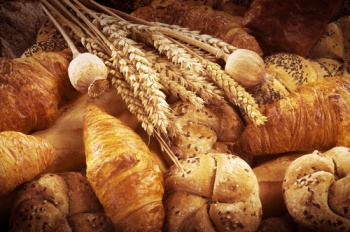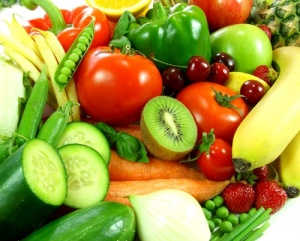Carbohydrates
| See Also | Clinical Nutrition |
|---|
Carbohydrates are a macronutrient that can be classified in several ways including simple (glucose, fructose, galactose, sucrose, lactose, lactulose) versus complex (starch, cellulose, hemicellulose, glycogen), refined versus whole grain, by glycemic index, and by glycemic load (GL).[1] In North America, typical diets are composed of 45-55% carbohydrates, but may contain as much as 60% in some cases. [2]
Contents
Food Sources
The food sources of carbohydrates include:
- Grains such as cereals, breads, baked goods, pasta and rice have a high carbohydrate content.
- Fruits and Vegetables contain carbohydrates in varying amounts
Uses
When discussing the effect of carbohydrate intake on health it is important to evaluate carbohydrate quality as type of carbohydrates consumed have variable effects on health factors such as glucose-insulin homeostatis, triglyceride levels, and inflammation.[1].
- Carbohydrates are primarily used as a fuel source and have an energy density of 4kcal/g.
Deficiency Symptoms
All carbohydrates needed in the body can be synthesized from other sources, meaning dietary carbohydrates are not always essential. However most foods do have some carbohydrate content, so a frank deficiency in carbohydrate consumption would normally indicate a starvation state. In cases of impaired glucose metabolism, such as type II diabetes, inadequate intake of carbohydrates can lead to Hypoglycemia.
Excess Symptoms
As with all macronutrients, excess consumption of carbohydrates leading to excessive daily caloric intake will lead to weight gain and eventual elevation in BMI. There is no evidence that percent energy consumed from any one source has an appreciable effect on weight gain or loss. [1]
Intake Considerations
It is generally recommended that a balanced diet contain 40%-60% carbohydrates depending on lifestyle, body composition, health history, disease risk factors, and health goals. For a more detailed list of recommended intake of carbohydrates and other macronutrients visit Health Canada's Dietary Reference Intakes for Macronutrients More important than strictly the amount of carbohydrate consumed is the source.
Fruits and Vegetables
- Increased intake of fruits and vegetables has been associated with a lower risk of coronary heart disease (CHD), stroke, and type II diabetes. Diets which focus more heavily on vegetables and fruits are associated with beneficial changes in several risk factors for cardiovascular disease including lowered blood pressure, lipid levels, insulin resistance, inflammation, and adiposity. [1] The benefits of fruit and vegetable intake are likely attributable to a number of micronutrients, fiber, phytochemicals, and the replacement of less healthy foods.
Whole Grains and Refined Grains
- Consumption of whole grains has been linked with lower risk of CHD, type II diabetes, and stroke. Glucose-insulin homeostasis, endothelial function, weight, and inflammation may also benefit significantly from whole grain consumption.
- Refined grains (white break, rice, packaged foods) contribute to higher glycemic index and glycemic load which have both been linked to increased risk of CHD and type II diabetes. It is recommended that intake of refined grains is limited, with an emphasis on replacement with whole grains, fruits, and vegetables. [1]
- Increased consumption of fibre has been shown to have the following beneficial impact on the following:[3]
- blood pressure
- Cancer risk
- satiety
- body weight
- constipation
- LDL levels
- irritable bowel syndrome
- Inflammatory Bowel Disease
In order to assess the quality of carbohydrate sources consumed, it is helpful to consider both glycemic index (GI) and glycemic load (GL).
- Glycemic Index is a measure used to represent the rise in blood glucose after the consumption of a particular food - it essentially tells us how quickly a foods carbohydrates can raise blood glucose levels. A value of 100 represents glucose and is used as the standard to measure other food sources against. Less refined, higher fiber foods generally have lower GI values than highly refined, starchy foods.[4]
- High GI foods include: white rice, table sugar, potatoes, baked goods, and white bread.
- Low GI foods include: asparagus, broccoli, brussel sprouts, spinach, tomatoes, yogurt, brown rice, cherries, milk, lentils, and soybeans.
Glycemic Load (GL)
- Glycemic Load considers both how quickly a food sources carbohydrates will raise blood glucose, and how much carbohydrate is contained in a particular food. High GL foods include: bagels, baked goods, juice cocktails, and white rice. Low GL foods include: soybeans, peas, multigrain bread, milk, and most fruits and vegetables. [4]
Lower GI and GL foods improve blood glucose, triglyceride, and LDL levels, and there is some evidence of improvement in inflammation and endothelial function. Higher GI and GL foods have been linked to increased risk of CHD and type II diabetes. Lower GI meals promote satiety and may benefit weight management.[1]
Metabolism
Carbohydrate digestion begins in the oral cavity, with the enzyme salivary amalyse which begins to break down starch. As food passes through the stomach and into the small intestine where pacreatic enzymes further digest consumed carbohydrates into smaller saccharides. Once carbohydrates are broken down into monosacchardies they are absorbed, pass through the liver, and are available to be utilized in the body. The monosaccharide glucose is the main fuel source for all cells in the body, and its intricate biochemical pathways in the body are well studied and understood. Complex carbohydrates take longer to breakdown in this process and thus minimize postprandial spikes in blood glucose and insulin, and contribute to increased satiety. [2]
References
- ↑ 1.0 1.1 1.2 1.3 1.4 1.5 Mozaffarian D (2011) Nutrition and Cardiovascular Disease: Chap 48 Braunwald's Heart Disease - A Textbook of Cardiovascular Medicine, 9th ed. Saunders.
- ↑ 2.0 2.1 Berdanier CD, Zempleni J (2009) Advanced Nutrition: Macronutrients, Micronutrients and Metabolism. CRC Press.
- ↑ Murray Michael T (1996) Encyclopedia of Nutritional Supplements, The Essential Guide for Improving Your Health Naturally Prima Publishing.
- ↑ 4.0 4.1 Pizzorno Joseph E, Murray Michael T (1993) Textbook of Natural Medicine, Elsevier.

